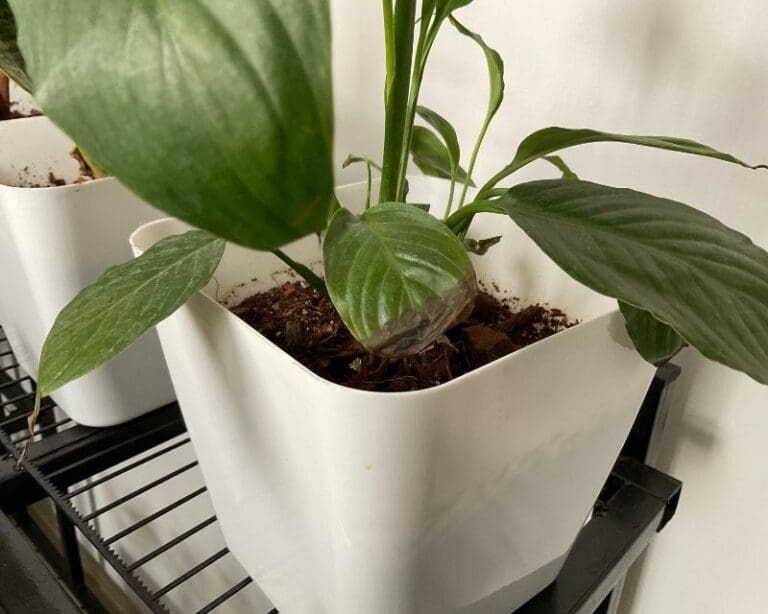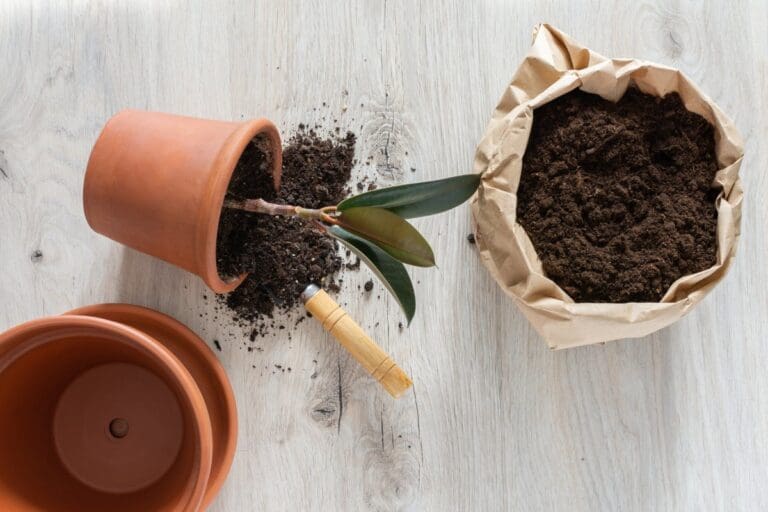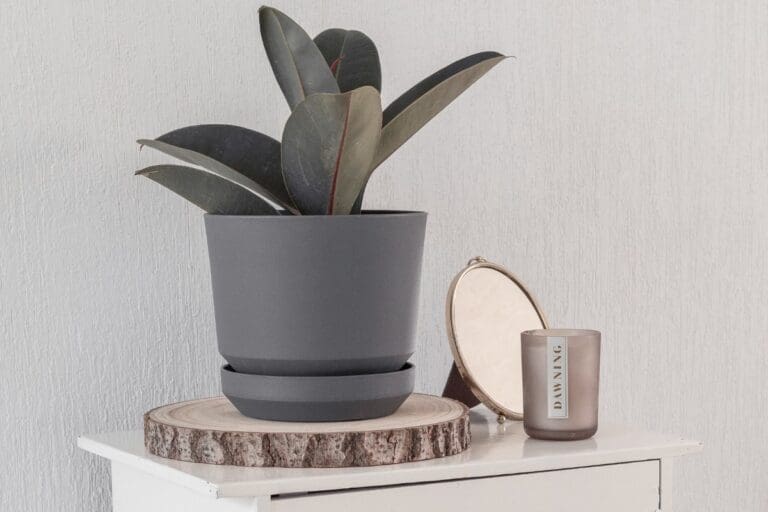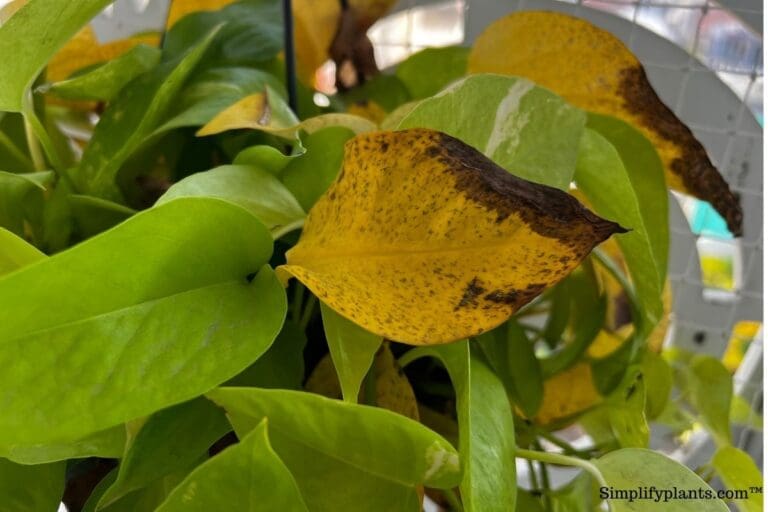Are Self Watering Pots Good For Calathea? (+Best Picks)
Calathea is a tropical houseplant that is fussy but exotic. So people find it hard not to have it in their houses. But getting the watering right for your Calathea can be tricky as it requires moist soil all the time. That brings us to self-watering pots.
Are self-watering pots good for calathea? Let’s find out.
Self-watering pots are an excellent choice for calatheas that require moist soil and slow bottom watering to thrive. You should fill the reservoir of the self-watering pot to max level and hold onto watering till all the water is below the minimum level for a few days before refilling it again.
In this article, I’ll take a look at how self-watering pots can benefit your Calathea plant. I will also give you all the information you need about self-watering pot before putting your Calathea in it.

Please note: Simplify Plants is reader-supported. Some links in the post are affiliate links and I get a commission from purchases made through links in the post.
What is a self-watering pot?
Before you know how well Calathea can grow in a self-watering pot, you must understand what it is and how it works.
Like other terracotta and plastic pots, a self-watering planter is also a pot. As the name suggests, this pot will self-water the plant itself. You don’t have to intervene regularly.
The pot looks like the usual traditional pot, but it carries a reservoir at the bottom. You can call it an extra outer pot that carries water.
You will only need to fill up this reservoir weekly or monthly, depending on Calathea’s demand. You only need to check the reservoir to fill it up as required. That’s all.
In these pots, the wick connects the reservoir and the main pot so that water quickly travels to Calathea’s root system and nourishes the plant.
Does Calathea like self-watering pots?
A self-watering pot is perfect for Calathea as these plants are fussy about their water needs. When you use a regular pot and don’t follow the proper watering schedule, it will get stressed.
If you are one who always does something wrong while watering, a self-watering pot would be great for Calatheas.
As they are tropical plants, they don’t enjoy drought or overwatering conditions and like to be in consistently moist soil. Thus, they will like to grow in a self-watering pot.
Moreover, your work reduces. You don’t have to worry about watering them correctly. You will end up making fewer mistakes in terms of watering the plant.
This self-watering pot will do its work great and will never let your plant sit either in dry or soggy soil.
Also read: How Often To Water Calathea? (A Complete Calathea Watering Guide)
How will Calathea benefit from self-watering pots?
Using self-watering pots is always a good decision for more or less all the houseplants, especially tropical plants, annuals, and perennials.
As Calathea is a tropical plant, it would enjoy growing in this pot. Let’s see how will they benefit from it:
The overflow hole will save the plant from root rot.
We often overwater Calathea without checking the moisture level and thus end up with root rot.
In some situations, it becomes impossible to save the plant. Many roots and leaves need to be pruned off even if the plant survives.
The self-watering pots will not make this mistake. The overflow hole in the pot will look after the fact that your Calathea never gets any excess water than required.
When water overflows and accumulates, this overflow hole will not let that happen. This hole will drain out and stop this overflow of water, saving your plant from overwatering or root rot.
It may happen that some part of your self-watering pot is not working well. In such conditions, too, the container empties the overflowed water from the hole.
Also read: How To Save Calathea From Root Rot? (Early Signs, Causes & Solution)
Productive use of water
If you are too cautious about the usage of water, in that case, you would want to save water. Using self-watering pots will make sure that no water gets wasted.
Some self-watering pots are said to have a moisture-wicking system. These are even more effective because if the chamber has standing water, the pot’s moisture-wicking system will take up that moisture and give it to the plant.
Watering the plant with a self-watering pot is much more systematic than usual spraying or using a watering can. Only little parts will get water with spraying, and it might even dry out quickly.
While using a watering can, some parts may or may not get water evenly. But by a self-watering pot, water gets distributed evenly to all the portions of the soil.
Efficient moisture levels

Typically, when you water your plant, the water travels from top to bottom. But in a self-watering pot, the water will enter from the bottom, and then the moisture will spread upwards to other portions of the soil.
This might feel like it won’t work well, but it does. The moisture evenly gets spread in the soil, and most importantly, the root system will rightly receive the moisture.
Reduces chances of fungal infections
Another advantage of using self-watering pots for Calathea is, they will be healthy and alive for a long time, without any fungal infections.
While watering Calatheas manually, water may get splashed on the leaves. The rule is to water the plant at the base, close to the soil, and avoid the leaves.
When leaves remain damp for long, there are chances of fungal infections.
Moist and damp leaves for prolonged periods make the plant vulnerable to pests and diseases.
With self-watering pots, the plant gets watered from the bottom to upwards. So, the leaves will be dry. Thus, there are minimal risks of fungal diseases in Calathea.
If you are misting, you should only clean the foliage. Let the leaves remain dry.
Helpful for nutrient supply
Along with watering, using a self-watering pot will also work very efficiently for feeding the plant with fertilizer.
The pot will help the plant get the nutrients directly in the root system – the disadvantage of using a self-watering pot.
There are not many demerits of using this kind of pot. There are all good things about it. However, you should consider both the good and bad of anything. There is only one problem in a self-watering pot.
In the hot weather, the reservoir will need more frequent refilling. This is because the hot climate will evaporate the water more than used.
We not only use self-watering pots to save the plant from water issues, but we also use them to free ourselves from regular checking of the plant.
But, if the pot needs to be checked and refilled frequently, then there is not much advantage available while using this pot.
But, other than this problem, everything is more or less good about this pot. But, you can stop the water from evaporating by keeping the pot in a place where there is less chance of evaporation.
How to plant and care for Calathea in a self-watering pot?
Let’s find out how you can care for a Calathea plant growing in a self-watering pot.
Choose the right size pot
The pot’s size should depend on the size of the plant. If you choose a small pot, the plant will outgrow the pot. You will again have to buy a big pot and plant your Calathea.
So, if you don’t want to spend so much money frequently, choose an ideal size so that the plant can grow well and spread its roots flexibly. It will also save money.
Use ideal potting mix

A suitable potting medium is significant to keep the Calatheas healthy.
Calathea enjoys growing in consistently moist, well-drained, and nutritious soil. They will neither enjoy drought conditions nor will they like being waterlogged.
Use a soil mix that contains 25% orchid bark, 20% coconut coir, 25% perlite, 10% activated charcoal, and 10% worm castings.
If you don’t get any of these ingredients, you can use store-bought potting mix for Calatheas and mix 30% to 50% of perlite or gravel with it.
Put the soil mix on the upper portion of the self-watering pot, the part that is separated from the bottom reservoir.
You can also fill the full pot like other traditional pots. But you have to keep some space to avoid the spilling of water.
Also read: What Kind Of Soil Is Best For Calathea? (Best Soil Mix For Calathea)
Plant the Calathea
Fill up the pot base a little, then at the center, place the plant. After planting, add the rest soil mix around the plant.
Don’t press the soil too much. Keep it firm but aerated.
If you plant Calathea seedling, make sure that it is hard enough, or else it can suffer transplant shock.
Fill up the reservoir with water
After planting, add water to the reservoir. The water-adding system can differ depending on the pot style.
Some self-watering pots have a tube as an inlet sideways where water is poured using a watering can or garden hose. Some other self-watering pots have a port where adding water is way easier.
Some pots have water level indicators where it’s easy to understand how much should be added or how much water is left. This will help you know when to add water to the reservoir.
But, some pots lack this indicator. So, filling up the right amount of water is essential.
However, in one way, you can understand. Most of the self-watering pots have an overflow hole. So, when you add too much water, it will flow out of that hole.
Like this, you can know whether the reservoir is filled or empty and when you should stop adding water.
Add mulch to the soil
Adding mulch to the soil is unnecessary as a self-watering pot will save you from both overwatering and underwatering. Still, adding mulch to the soil is not a bad idea at all. It will help in retaining moisture.
Mulch will also act as an insulator and regulate the temperature of the soil. It will also prevent weed growth. Add only 1-2 inches layer of it.
Use organic ingredients like dry leaves, moss, wood chips, straws, and grass clippings. They don’t have any harmful effects.
Another benefit of using organic mulch is that it will break down and add to the soil, making the soil more nutritious.
Fertilize the plant

Calatheas don’t require much fertilizer. Fertilizing them once a month would keep them healthy. Although, you should cut back on fertilizing when winter arrives. Calatheas remain dormant in winters.
Dilute a balanced fertilizer with water to feed your Calatheas. You can also use organic fertilizers like fish emulsion, bone meal, eggshells, or coffee grounds.
Also read: Should I Fertilize Calathea? (How Often+Best Fertilizer)
Clean your self-watering pot
One duty increases when you use self-watering pots, and that is cleaning. Cleaning once a month is essential to prevent algae growth in the pots. Cleaning is easy. You only need to open the reservoir to clean it.
When you use fertilizer or tap water, both the reservoir and potting mix will collect mineral salts. So, you need to flush the soil and clean the reservoir every month once after the growing season ends.
For cleaning, flush water from the top of the soil until the excess water flows out of the pot’s overflow hole. Continuing this 2-3 times will remove all the accumulated salts and hard minerals from the soil and reservoir.
Another way is to re-pot it with new soil after thoroughly cleaning the pot.
Some good self-watering pots
You will find many self-watering pots for your plant. But I would like to share some good self-watering pots which might be ideal for Calatheas.
Lechuza self-watering pot
<!– wp:common/insert-amalinkspro-shortcode {"shortcode":"Error: Unknown Link Type“} –>These are perfect planters, and your Calathea will thrive in them. Lechuza 13203 self-watering garden planter has a beautiful design that will give your interior space a touch of modernity.
These pots have a water level indicator that will guide you about the pot’s water level when it needs refilling and how much to add.
Though they don’t have much variety of colors, they have some attractive and sophisticated colors with a matte finish like white matte, purple garnet matte, slate matte, and nutmeg matte.
Lechuza cubic self-watering plant has an excellent cubic shape. The pot is made of plastic and is durable. As it is made of plastic, it is not heavy, and this pot is also UV and frost resistant.
Gardenix 7-inch self-watering planter
<!– wp:common/insert-amalinkspro-shortcode {"shortcode":"Error: Unknown Link Type“} –>Calatheas can grow from 6 to 36 inches. But if you want your Calatheas to be small and clean, you can use this 7-inch pot for a small plant.
Their design is effortless, and they too have a water indicator that informs you about the reservoir’s water levels.
Various colors are available, like gray, purple, teal, white, and terracotta.
Some pots have matte finishing, and some have glossy finishing.
You need to observe if too much water has been fed to the Calathea after filling the reservoir. Some growers complain that in this pot, excess water is fed to their plants.
Santino self-watering planter
<!– wp:common/insert-amalinkspro-shortcode {"shortcode":"Error: Unknown Link Type“} –>If you are still looking for a self-watering pot, try this pot for Calatheas. It is available in most of the popular sizes starting from 5.5-9 inches.
You can use several sized planters to grow several sized Calathea varieties. If your Calathea fits in any of these pot sizes, you can use this pot. This can give your interior space an impressive look.
The pot is plastic, and they are promising about no leakage. Air circulation within this pot will help the plant and its root system breathe well and avoid suffocation. This will keep them healthy for a long time.
The pot also promises to accurately water your plant once you fill the reservoir for one month. They are available in white, dark black, jade, and cream colors.
The pot has a small window at the front, which allows you to know the water level.
How long will the water last in self-watering pots?
Of course, a self-watering pot is time-saving, preventing overwatering and underwatering. But that’s not the only thing.
The self-watering pots need refilling when the reservoir goes empty. Now you need to know how long this water stays in the pot. Only then will it be time-saving. The water will stay at least 1 to 2 weeks.
Traditionally Calatheas require watering once a week. Keeping that in mind, you can consider that the water in the reservoir might stay for two weeks or some more days.
However, it depends on the surrounding weather and plant variety.
If the weather is hot and humid, the plant will drink more water because they need to remain moist. Some Calathea varieties consume more water than others.
For instance, the Zebrine variety consumes water faster than the Ornata variety.
Final thoughts
Self-watering pots are always a good choice for Calatheas. It will keep the plant from being underwatered or overwatered.
They will neither stand in drought nor will they stand in waterlogged soil. They will remain consistently moist all time, just like they love.
The self-watering pot coming up with a saucer will help maintain Calathea’s humidity levels. So, a self-watering planter can save you from a lot of worries.
If you want, you can use the traditional pots too for Calathea.
But if you don’t have time to water the plant daily or you are having a tendency of overwatering or underwatering the Calathea, then you can go for the self-watering pots. Calathea would also enjoy growing in them.
Also read: How To Fix Overwatered Calathea? (Possible Cause, Signs & How To Fix)
Source: NCBI, University of Florida, Wikipedia, Growing Indoor Plants with Success, Agriculture, and Natural Resources, University of California, Missouri Botanical Garden.
Recommended Garden Supplies
| Product Image | Our Recommended Gardening Supplies | Check Offers! |
|---|---|---|
Top Top
Top
Top
Top
Top
Top
Top
Top | rePotme Houseplant and Tropical Classic Potting Soil Mix | Check Offer On Amazon |
 Top
Top
Top
Top
Top
Top
Top
Top | Espoma Organic Indoor Plant Food | Check Offer On Amazon |
 Top
Top
Top
Top
Top
Top
Top
Top | GooingTop LED Grow Light 6000K Full Spectrum Clip Plant Growing Lamp | Check Offer On Amazon |
 Top
Top
Top
Top
Top
Top
Top
Top | Soil Moisture Meter | Check Offer On Amazon |
 Top
Top
Top
Top
Top
Top
Top
Top | Govee Hygrometer Thermometer, Bluetooth Enabled! | Check Offer On Amazon |
 Top
Top | LEVOIT Humidifiers for Large Room(Best For Plants) | Check Offer On Amazon |
 Top
Top
Top
Top
Top
Top
Top
Top | Upgraded DIY Automatic Drip Irrigation Kit, 15 Potted Houseplants Support | Check Offer On Amazon |
 Top
Top
Top
Top
Top
Top
Top
Top | Stainless Steel Heavy Duty Gardening Tool Set | Check Offer On Amazon |
 Top
Top
Top
Top
Top
Top
Top
Top | Bonide Insecticidal Soap | Check Offer On Amazon |
 Top
Top
Top
Top
Top
Top
Top
Top | Bonide 32 oz Spray Neem Oil for Organic Gardening | Check Offer On Amazon |
 Top
Top
Top
Top
Top
Top
Top
Top | Garden Safe Fungicide | Check Offer On Amazon |










